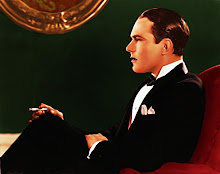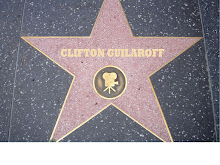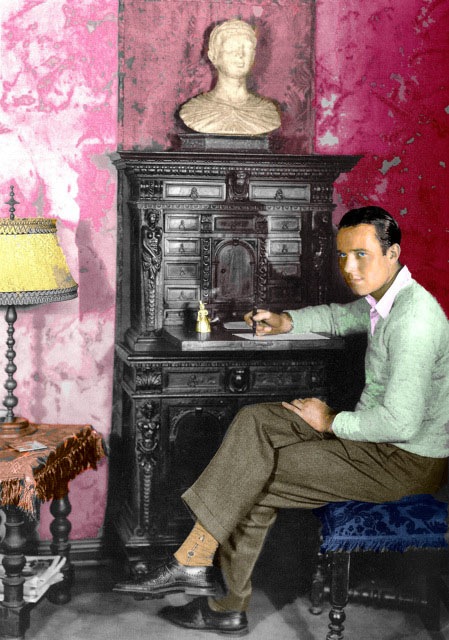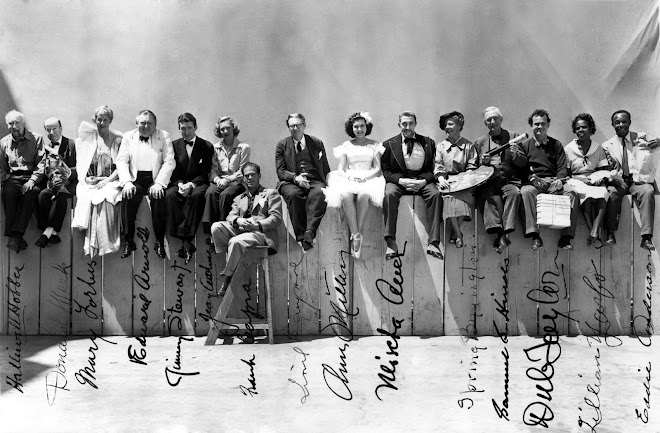this is the controversial "Study by Candlelight" Mother always says, "cigarettes are good for BOTH fine draperies and treasured art pieces- hack hack hack"
Mother always says, "cigarettes are good for BOTH fine draperies and treasured art pieces- hack hack hack"
I'm busy, so I'm gonna let Wiki tell you: William Goetz (March 24, 1903 – August 15, 1969) was an American Hollywood film producer and studio executive.
Born to a Jewish working class family in Philadelphia, Pennsylvania, Goetz was the youngest of eight children. His mother died when he was ten years old and shortly thereafter his father abandoned the family. Raised by older brothers, at the age of twenty-one he followed some of his brothers to Hollywood where he found work as a crew hand at one of the large studios. After a few years, he began doing production work and in 1930 was made an associate producer at Fox Films. That same year he married Edith Mayer, daughter of MGM studio head Louis B. Mayer – who at first was less than enthusiastic at the idea. Nevertheless, the marriage worked and they remained together for life.
In 1932, Goetz received the financial support necessary from his new father-in-law to become a minor partner with Joseph Schenck, the former president of United Artists, and Darryl F. Zanuck from Warner Brothers to create Twentieth Century Pictures. Zanuck was named president and Goetz served as vice-president. Successful from the very beginning, their 1934 film The House of Rothschild was nominated for an Academy Award for Best Picture. In 1935, they bought out the financially strapped Fox Films to create 20th Century Fox.
Goetz served as vice president of the new 20th Century Fox, but in 1942 he took charge of the studio temporarily when Zanuck, a World War I veteran, joined the United States military effort in the Second World War. Goetz liked the top role in the company and after Zanuck returned, relationships became strained and Goetz resigned to form his own independent company with Leo Spitz, a former lawyer who worked as a movie company advisor. Their partnership, under the name "International Pictures," ended its short-lived existence when they made a deal in July of 1946 to merge with the British Rank Organization's distribution arm and Universal Pictures. Goetz was made president and placed in charge of production for the newly merged "Universal-International" studio.
Although one of the studio executives who formulated the 1947 Waldorf Statement, Goetz later softened his stand on the issue. In 1949, Goetz called upon his close friendship with MCA head Lew Wasserman, one of the most powerful agents in Hollywood. They revolutionized the motion picture industry when they agreed to a deal whereby James Stewart was signed to a profit participation deal to act in a Universal film. In lieu of a salary for his performance, Stewart was guaranteed half of the film's profits, and the concept was soon negotiated for other stars who recognized the value of their own box office drawing power. Universal-International was acquired by Decca Records in late 1951, and the following year Goetz was let go by the new owners. After that, Goetz became an independent producer, making films such as 1957's Sayonara, which was also nominated for an Academy Award for Best Picture.
A very wealthy man, Goetz raised thoroughbred racehorses . His horse Your Host won the 1950 Santa Anita Derby and subsequently sired Kelso, a Hall of Fame inductee and one of the greatest horses in racing history.
Goetz and his wife also were major investors in art, acquiring a significant collection of impressionist and post-impressionist works. They owned paintings and sculptures by great artists such as Edgar Degas, Paul Gauguin, Claude Monet, Paul Cézanne, Berthe Morisot, Edouard Manet, Pierre-Auguste Renoir, Pablo Picasso, Amedeo Modigliani, Chaim Soutine, Pierre Bonnard, Jean-Baptiste Camille Corot, and Henri Fantin-Latour. In 1949, a controversy erupted over a Vincent van Gogh self-portrait called "Study by Candlelight" that Goetz had purchased two years earlier. The painting was declared a fake by art expert Willem Sandberg and the artist's nephew, V. W. van Gogh, resulting in an international debate amongst art experts. The painting remained controversial and was not put up for auction with the rest of the Goetz collection following Mrs. Goetz's death in 1987.
Monday, March 24, 2008
Today is William Goetz' birthday!!!!
Subscribe to:
Post Comments (Atom)
















_02.jpg)

2 comments:
"Sayonara" -- wasnt that shot up on the hill above Grauman's at that home turned brothel turned mai-tai bar and restaurant ?
I bought that faux-Gogh for a pretty penny and no one knows the difference. Actually, I didn't either.
Post a Comment